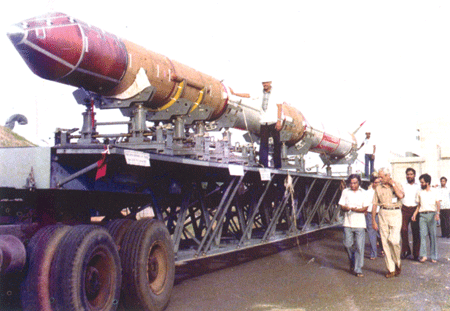As ISRO prepares to insert a cuboid smaller than a hatchback car into orbit around a planet that at its closest is 215 million kilometres away from Earth, here is how what might arguably be the government’s most efficient agency got here.
Early years
ISRO began as the Indian National Committee for Space Research in 1962, headed by Vikram Sarabhai.
Within a year, it launched its first rocket, the RH-75 of the Rohini series, to study geomagnetism in the atmosphere. The sounding rocket was slender, measuring only 75 mm in diameter, and was the first of several launched from the Thumba Equatorial Rocket Launching Station in Kerala.

India's first sounding rocket. Photo credit: NASA.
In 1968, Indira Gandhi dedicated the Thumba Equatorial Rocket Launching Station to the United Nations for research. ISRO itself was formed on Independence Day in 1969 and was brought under the Department of Space. In 1979, it moved its major launch site to Sriharikota in Andhra Pradesh, where it remains.
The foreign hand
The Soviet Union was closely involved with India’s space programme. A major milestone for ISRO was in 1975 when the Soviet Union launched India’s first indigenously made satellite, Aryabhata, from its launch site, Kaspustin Yar.

A file photo of the Aryabhata Satellite. Photo credit: ISRO.

A Russian stamp commemorating Aryabhata and Bhaskaras I and II.
The Russians continued to be closely involved with India’s space programme. India’s first man in space, Rakesh Sharma, was a member of a Soviet space mission in 1984. In this video, he describes his view of India from space to Indira Gandhi.
When the Soviet Union dissolved in 1991, India began to look elsewhere for satellite launch providers, even as it stepped up its efforts to develop its own. India’s first indigenously made multi-purpose satellite, INSAT-2A, took off from French Guyana in 1992, with the French satellite launcher, Ariane. The satellite, which could provide meteorological and telecommunication services and also served as a television broadcaster, had a mission life of seven years.
Satellite Launch Vehicles
ISRO began to experiment with satellite launch vehicles as early as 1979, in the hope of reducing its dependence on foreign launch services. These vehicles can put satellites into orbit around Earth at varying distances from the surface.
Its first programme, headed by APJ Abdul Kalam, had four Satellite Launch Vehicles, all carrying variations of the Rohini satellites. Two of these succeeded, two failed and this series was closed in 1983.

File photo of the SLV-3 launch. Photo credit: ISRO.

APJ Abdul Kalam (left) and Satish Dhawan accompanying SLV-3 to its launch pad. Photo credit: ISRO.
The Augmented Satellite Launch Vehicle series that followed it between 1987 and 1994 had a similarly unsuccessful run. Only its fourth and last launch in 1994 was entirely successful.
But the Polar Satellite Launch Vehicle that followed it changed the trend. After its first launch in 1993 failed, the 26 that followed until this June were continuously successful. These PSLVs could carry small loads of satellites that could provide basic telecommunication and mapping services.
As India’s PSLVs continued to be successful in the 1990s, Antrix, ISRO’s commercial arm, began to pitch its services to other countries. Of the 26 PSLV launches since 1993, 13 had payloads belonging to countries ranging from Norway to South Korea.

The PSLV C-14 at the launch site. Photo credit: ISRO.
ISRO’s Geosynchronous Satellite Launch Vehicles, first launched in 2001 were more complicated. These launchers could take heavier – and more valuable – satellites to a greater height. Five of ISRO’s eight GSLVs were launched without a hitch.
The biggest breakthrough for India’s satellite launchers came early in January when ISRO successfully launched the GSLV-Mk II that held India’s first indigenously developed cryogenic fuel engine. This means ISRO can launch even heavier satellites that could power manned missions.
Beyond Earth
As ISRO’s unbroken run of satellite launches continued, it turned its attention to targets beyond the planet.
In 2008, ISRO used one of its indigenous PSLVs to send an orbiter and lander, together called Chandrayaan-I, to the moon. The lander, emblazoned with the Indian flag, was built to crash onto the moon to collect data for future missions. Even though the lander disintegrated on striking the moon’s Shackleton crater, India still technically remains only the fourth country in the world to have its flag on the satellite.
Chandrayaan-I itself crash landed into the moon on August 29, 2009, a year before it was scheduled to time out, but the mission was deemed successful for having achieved 95% of its mission. One of these was to confirm evidence of water on the moon.
The Mars Orbiter Mission might be successful on Wednesday, but it is only one of ISRO’s many ambitious plans, including a manned space mission in the unspecified future (even as other countries wind up theirs) and another lunar mission in 2016 that will also include a lunar rover.
Buy an annual Scroll Membership to support independent journalism and get special benefits.
Our journalism is for everyone. But you can get special privileges by buying an annual Scroll Membership. Sign up today!